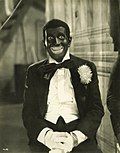Blackface
Blackface is a kind of costume or make up which involves putting black make-up on to imitate a racist image of a Black or African American person. Blackface became popular in the 19th century especially during Reconstruction after the American Civil War.
By the mid 19th century, blackface minstrel shows became a distinctive artform. It translated formal works, like opera, into popular terms for general audiences.[1]
Early in the 20th century, blackface came off the minstrel show. It became a form in its own right.[2]
However, in the United States, blackface became less popular after the civil right movement. It is offensive and racist.[3]
The videos for the Culture Club "Do You Really Want to Hurt Me" and Taco's "Puttin' On the Ritz" are videos in which actors in blackface appeared during the early 1980s.[4] The original video for "Puttin' On the Ritz" (1983) was not allowed due to the characters in blackface in that video.
References
- ↑ Behind the Burnt Cork Mask. Retrieved September 19, 2019.[dead link]
- ↑ Sweet, Frank W. (September 2000). History of the Minstrel Show. ISBN 9780939479214. Retrieved September 19, 2019.
- ↑ Don't Get What's Wrong with the Blackface?. Vox. https://www.vox.com/2014/10/29/7089591/why-is-blackface-offensive-halloween-costume. Retrieved September 19, 2019.
- ↑
Blackface Media
This reproduction of a 1900 William H. West minstrel show poster, originally published by the Strobridge Lithographing Company, shows the transformation from a person of European descent to a caricature of a dark-skinned person of African descent.
The Dreadnought hoaxers in Abyssinian costume
The white American actor John McCullough as Othello, 1878
Sinterklaas and his Black Petes arrive by boat at the start of a procession in Nijmegen (Netherlands), 2016
Tannenbaum, Rob; Marks, Craig (27 October 2011). I Want My MTV. ISBN 9781101526415. Retrieved September 19, 2019.






